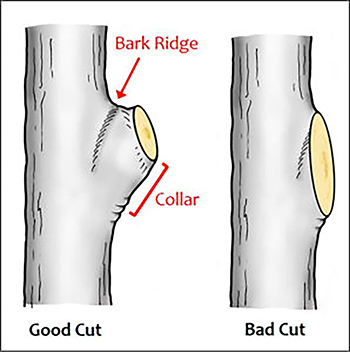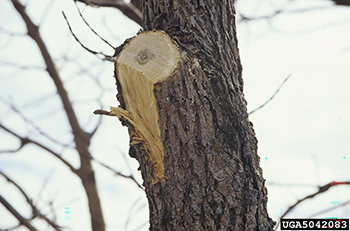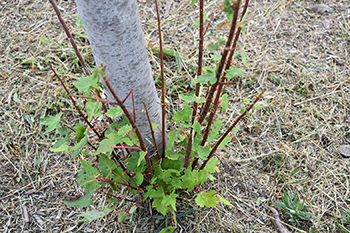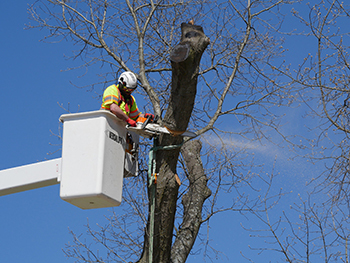Winter pruning tips – snip or saw your way to healthier trees
By RACHEL COALE
Forest Resources Division
Michigan Department of Natural Resources
With frost curling sparkles across the windows and fuzzy socks adorning your feet, gardening season is a warm, summer memory put to bed under a blanket of snow.
Or is it?
It’s easy to think that yardwork is over during snow season, but there’s a perfect winter task waiting if you’re itching to get outdoors – pruning.

Pruning is more than just giving your trees and shrubs a trim. Sure, whacking branch ends off will make a tree neater, but a bit of technique will help ensure its health and vitality. Pruning removes damaged or sick parts of trees and can stimulate new growth and fruit production.
“The best time to prune most trees is in late winter to early spring before growth starts,” said Kevin Sayers, Michigan Department of Natural Resources Urban and Community Forestry program leader. “That’s January to March in Michigan.”
During this time, trees are dormant, and sap is not flowing, which minimizes the impact of cuts from pruning. You can also see the shape of broadleaf, or deciduous, trees best when branches are not obscured by leaves.
The potential for transfer of diseases by insects is also at its lowest in winter since it’s too cold for beetles and flies to move about. This is important for oak trees that can be infected fatally with oak wilt disease in warmer months when beetles move from tree to tree.
Most trees and shrubs should be pruned in winter, except spring-flowering plants like hydrangeas and dogwoods. Prune them after they flower.
How to prune
Specific pruning techniques can vary by plant species, blooming time and whether the tree produces fruit, but the basics remain the same.
|

To prune your tree, look at its overall branch structure and shape.
First, remove diseased, dead or broken branches. Then cut any branches that cross and rub together, as well as any that make the tree grow lopsided. Work around the tree, not just from one side, so the shape is even.
Prune away suckers sprouting from the base of single-stem trees and trim off low-hanging branches. If unsure, ask yourself, “will I be whacked in the face when I mow the lawn?”
When you prune away twigs and branches, find the sweet spot: don’t leave long stubs that can slow healing, but don't make flush cuts that remove the branch collar, the slight swelling where the branch meets the stem.
Wounds created by cuts too close to the trunk can injure the tree. Always make pruning cuts on the outside of the natural branch collar.
Pruning should improve air flow in your tree or shrub by opening up the crown but avoid removing more than 25% of the tree in any single year so it can recover more easily.
The “less is more” rule applies to pruning. Good pruning is not measured by the quantity of material removed, but rather by the quality.
Remove heavy or long limbs using the “three-cut method” to prevent damage to your tree. First, cut the end third of the branch off. Then remove the middle third, and finally, cut the remaining third above the branch collar. This prevents a heavy branch from tearing off a strip of bark as it falls.
|

To finish, do you need to use pruning spray? Tree care professionals say no.
“Trees are able to naturally repair and seal themselves after pruning, so treatment is not necessary,” said Lawrence Sobson, DNR urban forester and partnership coordinator.
Equipment
Having the right tool for the job will make pruning quicker and easier. Depending on the size and type of plant you’re growing, here are a few options to consider investing in:
- Handheld pruning shears – use for small trees and shrubs, roses and detail work.
- Long-handled loppers – best for shrubs, hedges and larger fruit trees.
- Pruning saw or long-handled pole saw – used to remove low-hanging overhead limbs, large branches or brush.
Maintain your tools by keeping a sharp edge, which will help neatly cut twigs instead of crushing them with dull blades. Keep them clean by wiping them with alcohol or a cleaning wipe after use to prevent the transfer of diseases between plants. A bit of oil before storing tools can help keep blades and moving parts from rusting.
|
When to DIY and when to call in a professional
Some pruning tasks are manageable at home, while others are best left to experts.
If you are dealing with large, heavy branches or tall trees, especially those located near a building or electrical wires, don’t take risks. Tree care can be dangerous, so have tough jobs handled by a professional tree service company.
Find a landscaping company accredited with the Tree Care Industry Association or a certified arborist with the Michigan chapter of the International Society of Arborculture.
If your pruning project is do-it-yourself sized, gather your gear and size up the scene before starting.
Work gloves are a must for pruning, especially if you’ll be dealing with a thorny plant. If you’re working on a particularly overgrown or dense tree, also consider putting on a pair of safety glasses or goggles before diving in to avoid getting poked in the eye.

When trimming low-hanging branches, a long-handled pole saw is your friend, allowing you to work from the ground. Be aware that branches can swing and strike you if only partially cut through, so make decisive cuts, work in small sections at a time and be aware of your surroundings.
When dealing with anything taller than you can reach with a pole saw, thoughtfully evaluate your abilities and safety.
“Ladders are useful for changing lightbulbs and cleaning gutters, but are not usually appropriate for pruning tree limbs,” said Sayers.
Ladders are unstable and usually aren’t large enough to reach desired branches for pruning mature trees, which can be anywhere from 20 to 100 feet tall. In most cases, if you think you need a ladder to accomplish your work, you probably need a professional instead.
From homes for birds to tasty fruit to cooling shade in the summertime, trees and shrubs provide an array of natural benefits. With the right knowledge, tools and care, your trees and shrubs will be happier, healthier and thriving.
Once your winter pruning is accomplished, it’s time to start planning for spring planting season. Get ready with tips from our Mi Trees resources and add your new trees to the community planting map.
Check out previous Showcasing the DNR stories at Michigan.gov/DNRStories. To subscribe to upcoming Showcasing articles, sign up for free email delivery at Michigan.gov/DNREmail.
|
Note to editors: Contact: John Pepin, Showcasing the DNR series editor, 906-226-1352. Accompanying photos and a text-only version of this story are available below for download. Caption information follows. Credit Michigan Department of Natural Resources, unless otherwise noted.
Text-only version of this story.
Cuts: This graphic shows the difference between a good pruning cut, outside the tree’s natural branch collar, and a bad one, a flush cut that removes the branch collar. (Image from University of Minnesota)
Professional: If large or tall trees, especially those located near a building or electrical wires, need pruning, you should let professionals with specialized equipment handle the job. (Photo from Michigan State University Department of Forestry)
Pruning: A diagram and instructions explaining the “three-cut method” of pruning to prevent damage to your tree. (Image from TreesAreGood.org)
Rip: Heavy or long limbs should be removed using the “three-cut method” to prevent the branch from tearing off a strip of bark as it falls, as shown in this photo. (Photo by Joseph O'Brien, USDA Forest Service)
Sprouting and Suckers: Prune away suckers sprouting from the base of single-stem trees as part of your winter tree care.
|